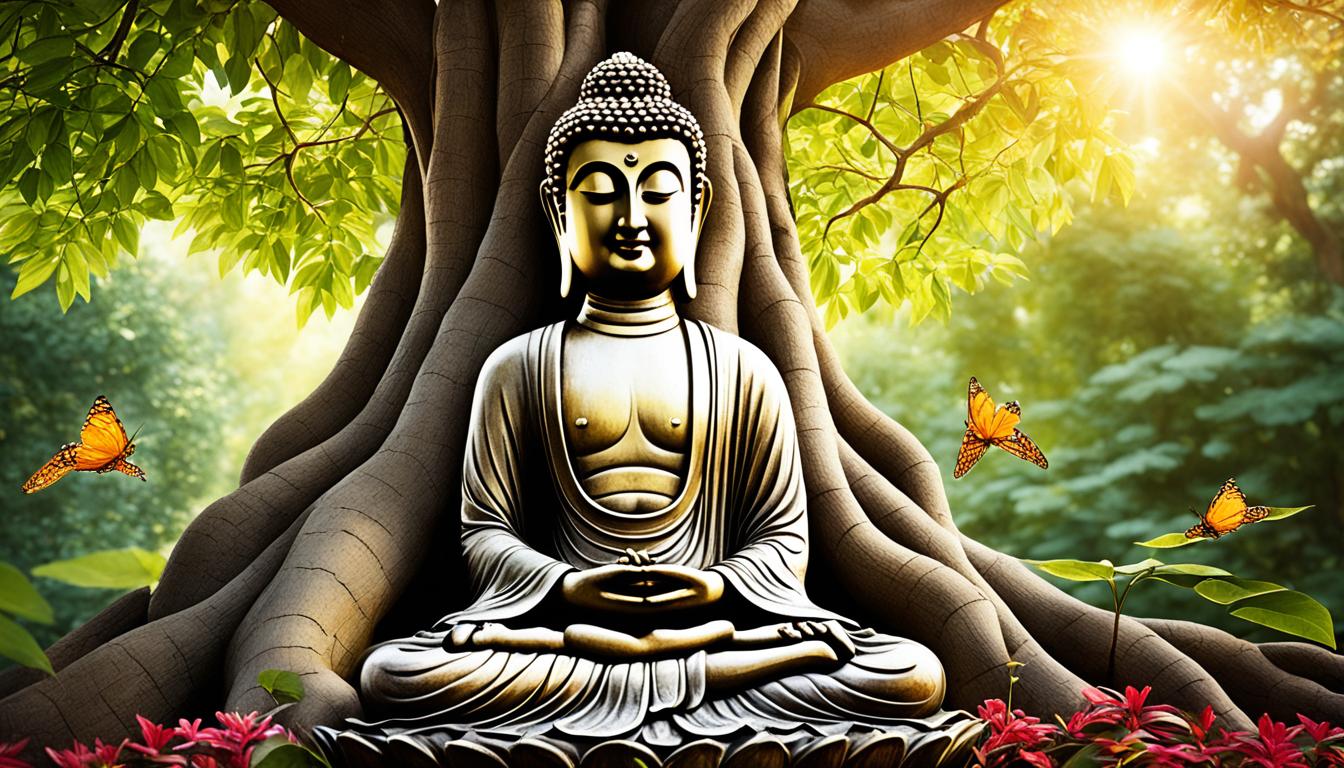Buddhism, with its rich teachings and profound philosophy, offers a pathway to inner peace. At the heart of this spiritual tradition is the figure of Buddha, whose wisdom continues to inspire millions around the world.
“Thousands of candles can be lighted from a single candle, and the life of the candle will not be shortened. Happiness never decreases by being shared.” – Buddha
As you delve into the world of Buddhism, you will discover the transformative power of Buddha’s teachings and the historical significance of his life. From addressing the nature of suffering to providing guidance on the path to enlightenment, Buddha’s wisdom resonates deeply with those seeking solace and understanding.
In this article, we will explore the fundamental teachings of Buddhism and the role of Buddha in guiding individuals towards personal and societal harmony. We will delve into Buddha’s life story and the philosophical insights he shared with his followers. Furthermore, we will examine the practices for cultivating inner peace, such as meditation and the study of sacred scriptures. Finally, we will explore the relevance of Buddhism in modern society, offering insights on mindfulness and compassion to navigate the complexities of the world.
Key Takeaways:
- Buddhism offers a pathway to inner peace through the teachings of Buddha.
- Buddha’s wisdom can inspire and guide individuals on their journey towards enlightenment.
- Practices such as meditation and the study of sacred scriptures are essential for cultivating inner peace in Buddhism.
- Mindfulness and compassion are practical applications of Buddhism’s teachings in addressing modern challenges.
- The pursuit of inner peace requires continuous self-reflection and growth.
The Insights of Buddha in Buddhism
Buddha’s life story and teachings hold great significance in Buddhism. From his birth and enlightenment to his passing, Buddha’s journey is a source of inspiration for followers of Buddhism. His teachings focus on achieving enlightenment and understanding the nature of reality. Let’s explore the life story of Buddha and the philosophical insights he shared with his followers.
Buddha’s Life Story
The story of Buddha begins with his birth as Siddhartha Gautama in ancient India. Born into a noble family, Siddhartha lived a sheltered life, shielded from the realities of suffering. However, his encounters with old age, sickness, and death outside the palace walls prompted him to seek a deeper understanding of life’s ultimate truths.
At the age of 29, Siddhartha renounced his luxurious lifestyle and embarked on a spiritual quest for enlightenment. He spent years studying under various teachers, practicing extreme asceticism, and engaging in deep introspection. Ultimately, Siddhartha realized that neither extreme indulgence nor severe self-mortification could lead to enlightenment.
Under the Bodhi tree in Bodh Gaya, Siddhartha achieved enlightenment at the age of 35. From that moment on, he became known as Buddha, which means “the awakened one.” Surrendering to the cycle of birth, death, and rebirth, he dedicated himself to sharing his insights with others, offering guidance for attaining liberation from suffering.
The Philosophical Insights of Buddha
Buddha’s teachings form the foundation of Buddhist philosophy and spiritual practice. The Four Noble Truths and the Eightfold Path are central to his teachings, offering a roadmap for attaining enlightenment and freeing oneself from the cycle of suffering.
“The Four Noble Truths,” as taught by Buddha, are:
- The truth of suffering: Life is filled with inevitable suffering and dissatisfaction.
- The truth of the origin of suffering: Desire and attachments lead to suffering.
- The truth of the cessation of suffering: Ending desire and attachments leads to the cessation of suffering.
- The truth of the path to the cessation of suffering: Practicing the Noble Eightfold Path leads to the end of suffering.
The Noble Eightfold Path encompasses eight principles for living a mindful and virtuous life:
- Right understanding
- Right thought
- Right speech
- Right action
- Right livelihood
- Right effort
- Right mindfulness
- Right concentration
By following this path, individuals can cultivate ethical conduct, mental discipline, and wisdom, ultimately leading to enlightenment and liberation from suffering.

Image: Buddha’s Enlightenment
| Significance of Buddha in Buddhism | Buddha’s Life Story | Buddhist Philosophy on Enlightenment |
|---|---|---|
| Provides inspiration and guidance for followers | Born as Siddhartha Gautama, renounced worldly life, attained enlightenment under the Bodhi tree | Teachings on Four Noble Truths and Eightfold Path lead to liberation from suffering |
Practices for Inner Peace in Buddhism
Discover the transformative power of Buddhist meditation practices and sacred scriptures that can guide you on the path to inner peace. By incorporating these practices into your daily life, you can cultivate mindfulness, find inner calm, and develop a profound connection with yourself and the world around you.
Meditation: Calming the Mind, Nurturing the Spirit
Meditation is a fundamental practice in Buddhism, allowing you to quiet the noise of the outside world and create space for inner reflection. Through dedicated practice, you can train your mind to focus, find clarity, and develop a sense of presence. By observing your breath and observing your thoughts without judgment, you can cultivate mindfulness – a state of heightened awareness and acceptance of the present moment.
Take a few moments each day to sit in stillness and practice meditation. Find a comfortable posture, close your eyes, and bring your attention to your breath. Allow yourself to let go of any distractions and simply be present with your breath, observing each inhalation and exhalation.

Sacred Scriptures: Wisdom from Ancient Texts
In addition to meditation, sacred scriptures in Buddhism offer profound wisdom and guidance for those seeking inner peace. The Dhammapada and Surangama-Sutra are examples of revered texts that contain timeless teachings that can illuminate your spiritual journey.
The Dhammapada, often referred to as the “Path of Truth,” is a collection of verses that encapsulate the essential teachings of Buddha. It provides practical insights into ethical living, mindfulness, and the cultivation of wisdom.
The Surangama-Sutra explores the nature of consciousness and delves into the myriad ways in which our minds create illusions and suffering. By studying and contemplating these sacred scriptures, you can gain a deeper understanding of the human condition and find guidance for transcending suffering.
The Table of Buddhist Meditation Practices:
| Practice | Description |
|---|---|
| Anapanasati (Breath Awareness) | Focus on the breath to develop concentration and mindfulness. |
| Vipassana (Insight Meditation) | Develop insight into the impermanent and ever-changing nature of reality. |
| Metta (Loving-kindness Meditation) | Cultivate a compassionate and loving attitude towards oneself and others. |
| Tonglen (Sending and Receiving Meditation) | Transmute suffering into compassion by breathing in pain and exhaling love and healing. |
*Table: Buddhist Meditation Practices*
These meditation practices provide various methods for deepening your spiritual practice and cultivating inner peace. Experiment with different techniques and find the ones that resonate with you the most. Incorporate them into your daily routine, allowing them to become a source of refuge and inner calm.
Buddhism’s Relevance in Modern Society
Buddhism offers valuable teachings that address the challenges of modern life, emphasizing the importance of mindfulness and compassion.
Mindfulness, defined as the practice of being fully present and aware of one’s thoughts, feelings, and sensations, has become increasingly relevant in a world consumed by distractions. By cultivating mindfulness, individuals can navigate the complexities of daily life with clarity and focus. It allows you to be fully engaged in the present moment, enhancing your ability to make conscious choices and find peace amid the chaos.
Compassion, both towards oneself and others, is another vital aspect of Buddhism that holds immense significance in the modern world. In a society marked by conflict and division, fostering understanding, empathy, and kindness is essential for building harmonious relationships and addressing social challenges. By embracing compassion, you contribute to creating a more inclusive and compassionate world.
Buddhism teaches that mindfulness and compassion are not only internal practices but also extend to the wider community and environment. Incorporating these principles into your daily life can lead to positive transformations, both personally and collectively.

| Benefits of Mindfulness in Modern Life | Benefits of Compassion in Modern Society |
|---|---|
| 1. Reduces stress and anxiety | 1. Promotes understanding and empathy |
| 2. Enhances focus and concentration | 2. Fosters harmonious relationships |
| 3. Improves emotional well-being | 3. Creates a more inclusive society |
| 4. Cultivates resilience and adaptability | 4. Addresses societal challenges with empathy |
| 5. Promotes self-awareness and personal growth | 5. Inspires positive social change |
By integrating mindfulness and compassion into your life, you can navigate the modern challenges and find a deep sense of peace and fulfillment. These teachings remind us of our interconnectedness and the power of kindness in creating a more compassionate and sustainable world.
Conclusion
The teachings of Buddha in Buddhism offer a profound roadmap to individuals seeking inner peace. By embracing the impermanence of life and cultivating mindfulness, individuals can find balance and harmony through the Middle Way. Understanding the Four Noble Truths empowers individuals to address the root cause of suffering and embark on a transformative journey towards inner tranquility.
Meditation, silence, and letting go of attachments are invaluable practices in deepening one’s connection with oneself and the world. Through meditation, you can quiet your mind, cultivate self-awareness, and develop a sense of presence. Silence allows you to listen to the whispers of your inner being and find solace in the present moment. Letting go of attachment liberates you from the shackles of material desires and fosters a deeper sense of contentment.
Ultimately, the pursuit of inner peace is a personal journey that requires continuous self-reflection and growth. The teachings of Buddha in Buddhism provide timeless wisdom and guidance to navigate the complexities of life. By incorporating these teachings into your daily life, you can unlock a profound sense of inner peace, serenity, and fulfillment.
FAQ
What is the role of Buddha in Buddhism?
Buddha is considered the founder and spiritual leader of Buddhism. His teachings and life story hold great significance for followers of the religion.
What are the fundamental teachings of Buddhism?
Buddhism teaches individuals to achieve enlightenment and understand the nature of reality. The teachings focus on concepts such as impermanence, mindfulness, compassion, and the Four Noble Truths.
Can meditation help cultivate inner peace in Buddhism?
Yes, meditation is a cornerstone of Buddhist practice. It helps individuals calm their minds, focus their thoughts, and develop mindfulness, which can lead to inner peace.
Are there any sacred scriptures in Buddhism?
Yes, Buddhism has sacred scriptures such as the Dhamapada and Surangama-Sutra. These scriptures provide guidance for practitioners seeking inner peace and spiritual growth.
How can Buddhism’s teachings on mindfulness and compassion be applied to modern challenges?
Mindfulness can help individuals navigate daily life and cultivate a deeper sense of awareness and presence. Compassion fosters understanding and empathy in a world marked by conflict and division, addressing modern challenges.
How can one find inner peace through the teachings of Buddha in Buddhism?
By embracing impermanence, practicing mindfulness, finding balance through the Middle Way, cultivating compassion, and understanding the Four Noble Truths, individuals can embark on a transformative journey towards inner tranquility.

